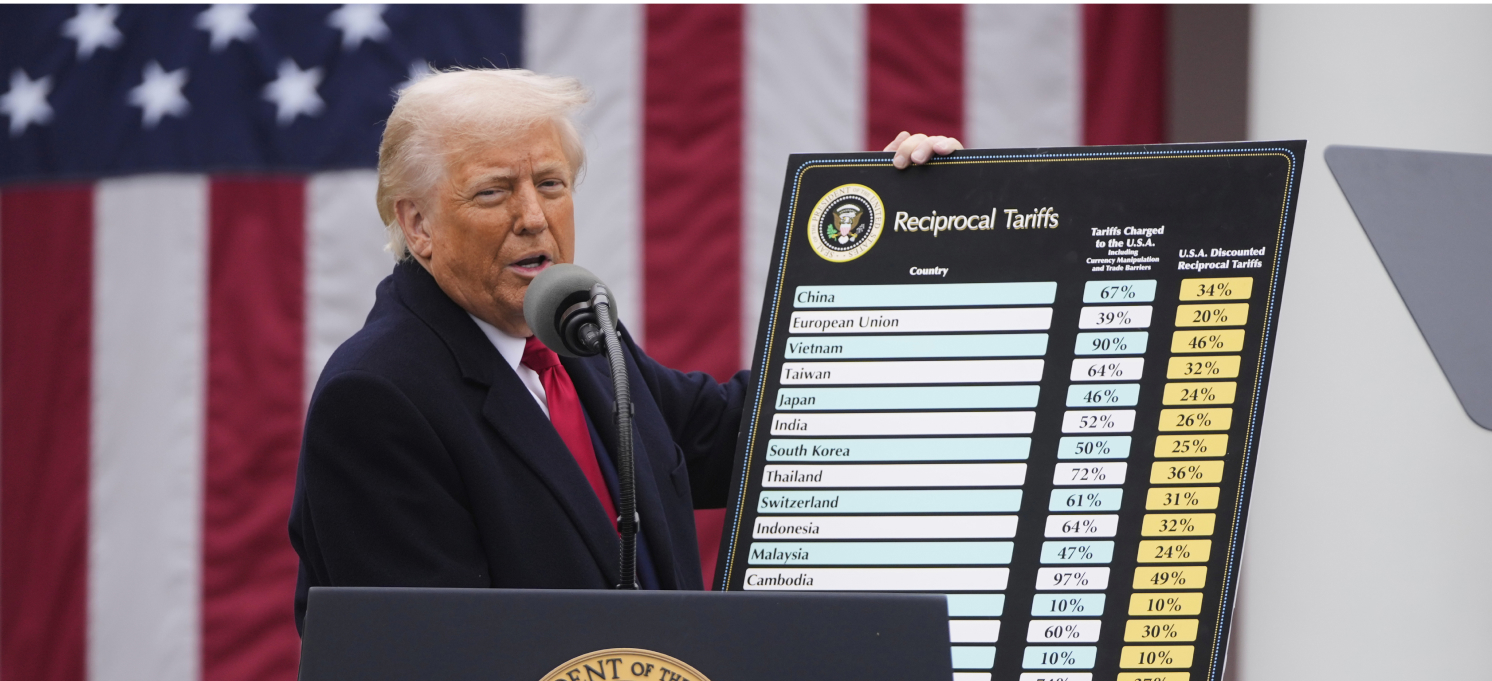
Trump’s tariffs mean long-term pain for Moscow
Hello! Welcome to your weekly guide to the Russian economy — written by Alexander Kolyandr and Alexandra Prokopenko and brought to you by The Bell. This week we look at how Trump’s tariffs will affect Russia (even though Russia didn’t appear on the tariff list), and the consequences of Russia’s falling revenues from oil and gas.
Russia left of Trump’s tariffs list – but set to suffer anyway
While Russia was not one of the countries on which United States President Donald Trump this week imposed tariffs, the impact of a protracted global trade war will be significant.
Why wasn’t Russia on the tariff list?
The White House said Russia was not hit with tariffs because there was no trade between the two countries due to the Western sanctions imposed as a result of the full-scale invasion of Ukraine. But that's not quite true. In 2024, exports of Russian goods to the U.S. totalled $3.27 billion (the lowest in more than 30 years), and the U.S. exported $526 million worth of goods to Russia. These are tiny numbers when it comes to U.S. trade, but, for example, Lesotho, an African kingdom with a population of 2 million, sells even less to the U.S. – about $2 billion worth of goods a year – but was hit with a 50% tariff.
If we apply the formula Trump used to determine the size of tariffs on trading partners, then Russia should have been hit with a 40% tariff (based on 2024 numbers). That said, in the last pre-war year of 2021, the two countries enjoyed almost equal trade – which would have meant Russia was hit with a 10% tariff.
It's possible that Russia’s absence from the list could be a deliberate move by Trump to gain leverage over President Vladimir Putin in the ongoing Ukraine peace talks between the two countries. But the trade volumes at stake are so insignificant that they are unlikely to influence the Kremlin, particularly while sanctions remain in force.
Consequences for Russia’s economy
The small volumes of U.S.-Russia trade did not stop Russia’s stock market from falling in line with its counterparts in other countries following Trump’s tariff announcement. But the Moscow Exchange’s drop of 2.3% on Thursday was relatively modest. The biggest loser was fertilizer producer PhosAgro. The ruble fell just 0.5% against the U.S. dollar.
While the immediate effects were minor, the indirect consequences could be much more significant. Oil prices are the main risk. The outbreak of a full-blown trade war would result in a slowdown in global growth, especially in China and other Asian countries. And low growth would lead to a fall in the price of oil, Russia’s main export. Prices for oil dropped by more than 10% the 4-years low, as on top of the tariffs, OPEC+ tripled a planned output hike for May.
“Prices could certainly drop to about $60 in the near future. It all depends on the outcome of the U.S. talks with various countries over tariffs and the duration of the trade conflict,” said Abki Rajendran, director of Oil Market Research at Energy Intelligence.
With the price of oil lower than expected, and the ruble stronger than expected, Russia’s revenues are below where they should be for this point in the year. And if oil prices fall yet further amid expectations of a global economic slowdown, then the Kremlin might be obliged to borrow more money to cover the widening fiscal deficit. In the middle of a trade war, this won’t be cheap.
A fall in revenue from energy exports could make it harder for Russia’s Central Bank to cut interest rates – and higher rates mean that the cost of borrowing will be higher, putting a brake on Russian economic growth (which is already expected to slow this year).
In addition, a global trade war weakens the position of Russian oil and gas on world markets, according to Alexander Isakov of Bloomberg Economics. Not only does it reduce the likelihood of Russia being able to increase exports to the European Union, it makes it more likely that Asian buyers will seek to pay even less. The fact is that the EU, China and other countries will want to reduce their trade imbalances with the U.S., and one way to do this is to increase imports of oil and LNG from the U.S. (resulting in fewer imports from Russia).
At the same time, Russia will become increasingly dependent on China, which is facing a fall in the volume of its exports to the U.S., and a devaluation of the yuan. The former requires it to increase exports to other markets (like Russia) and the latter makes this more tempting.
Why the world should care
At first glance, Russia is just an observer in an unfolding global trade war. But Trump’s tariffs look set to cause indirect problems in the coming months via reduced revenue from raw materials, higher interest rates for longer – and a rising dependence on China.
Falling energy revenues cause budget shortfall
Russia’s revenue from oil and gas exports was down 10% in the first quarter of this year to 2.6 trillion rubles ($90 billion). That was 65.6 billion rubles ($700 million) less than envisaged by Russia’s budget planning, according to the Finance Ministry.
- The shortfall means that, under its self-imposed budget rules, the Finance Ministry must switch from buying gold and yuan to selling liquid assets from the National Welfare Fund. It’s the first time in a year that this has happened. From April 7 to May 12, therefore, gold and foreign currency worth the equivalent of 1.6 billion rubles will be sold every day. At the same time, the Central Bank will sell 8.86 billion rubles worth of yuan per day until the end of the second quarter. All things being equal, this will likely provide some support to the ruble, noted Gazprombank’s Yegor Susin.
- Falling revenue has mostly been caused by lower prices. Analysts last month started downgrading their oil price forecasts for this year. Goldman Sachs reduced its prediction for the price for Brent crude by $5 to $71 a barrel by the end of this year. Morgan Stanley and Bank of America also reduced their forecasts (both believe Brent will cost about $60 a barrel in the second half of 2025). JPMorgan expects the average oil price for this year to be $61 a barrel. Of course, Russian oil will cost even less – since the imposition of Western sanctions, Russian oil has been sold at a discount of about $10 a barrel to Brent.
- After Trump’s imposition of tariffs, and the OPEC+ meeting on Thursday at which the cartel announced that, from May, it would restore output three times faster than initially planned, the price of oil dropped rapidly.
- Russia’s Finance Ministry last month warned of the risk of reduced oil-and-gas revenues due to a deteriorating price environment, and admitted the budget deficit for the year could be greater than planned.
- “The statistics from the first quarter of 2025 reflect a risk of reduced oil-and-gas budget revenues connected with oil price corrections on the global market, an increased discount on Urals against Brent due to the Biden administration’s January sanctions, and a reduction in gas supplies to Europe. The consequences for the mineral extraction tax and export tariffs on gas will become more evident in the second quarter,” Kirill Rodionov, an expert from the Institute for the Development of Fuel and Energy Technologies, posted Thursday on messaging app Telegram.
Why the world should care
Oil-and-gas revenue makes up about a third of all Russia’s income. In 2025, the Finance Ministry had planned on an average oil price of $67.7 per barrel. But cheaper-than-expected oil coupled with a stronger ruble look set to cause some problems for Russia’s financial managers. And there are no easy options for raising money – the National Welfare Fund is shrinking fast, and borrowing remains expensive.
Figures of the week
Between March 25 and March 31, weekly inflation accelerated from 0.06% to 0.2%, according to the Economic Development Ministry. At the same time, annual inflation increased from 10.11% to 10.24%. This suggests that it is too early for the Central Bank to consider embarking on a cycle of rate-cutting.
The value of the National Welfare Fund last month dropped from 11.88 trillion rubles to 11.75 trillion rubles. The fund’s liquid assets were down from 3.39 trillion rubles to 3.26 trillion rubles. The amount of Chinese yuan remained steady, while the amount of gold fell from 174.6 tons to 168.2 tons.
Russia is unlikely to launch its digital ruble until the middle of next year, sources told Frank Media citing conversations between Central bankers and commercial banks. In late February, Central Bank head Elvira Nabiullina announced the regulator’s decision to postpone the launch of the digital currency from a previously-announced July 1. She did not give a new start date. Previously, there had been speculation the Central Bank’s digital currency could be a way to help Russian firms evade Western sanctions.
Further reading
How Will Russia Reconstitute Its Military After the Ukraine Conflict?



PAID SUBSCRIPTION LAUNCH
From May 1, 2025, The Bell in English will no longer be free
From May 1, 2025, all The Bell’s newsletters and online content will be behind a paywall. We have taken this decision so that The Bell can remain financially independent, and maintain our high standards of journalism and economic expertise







